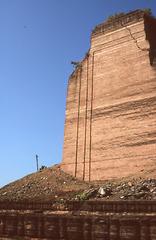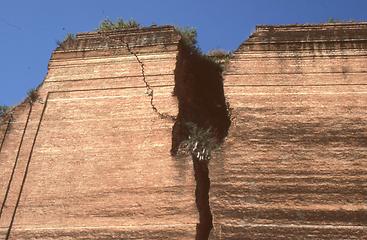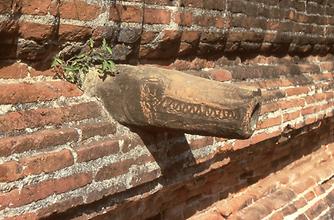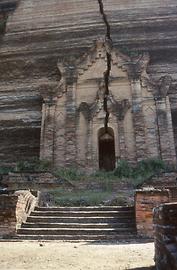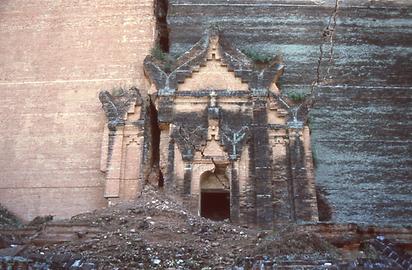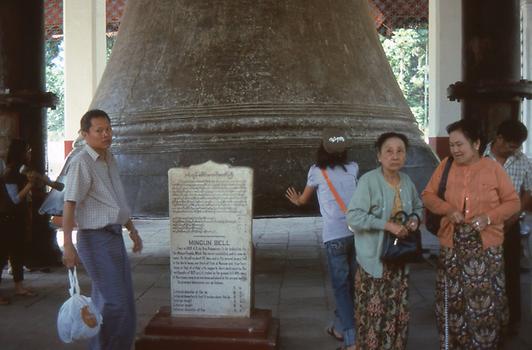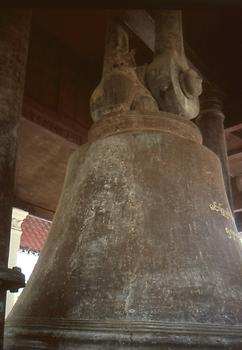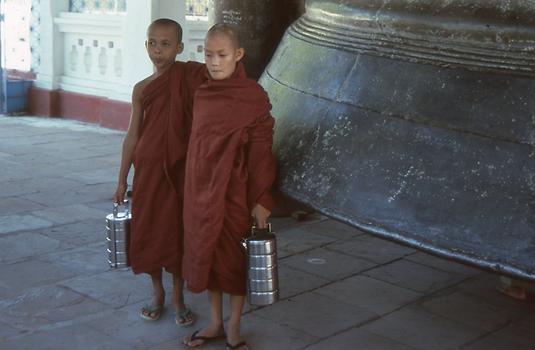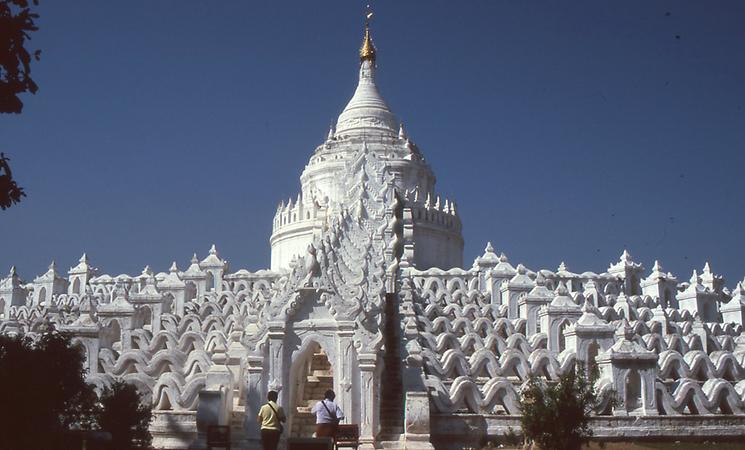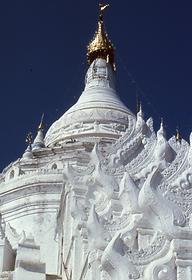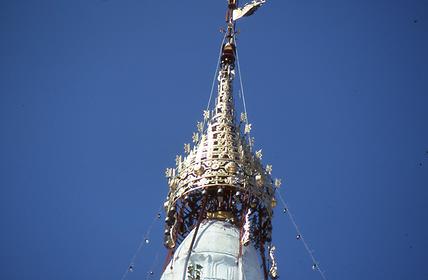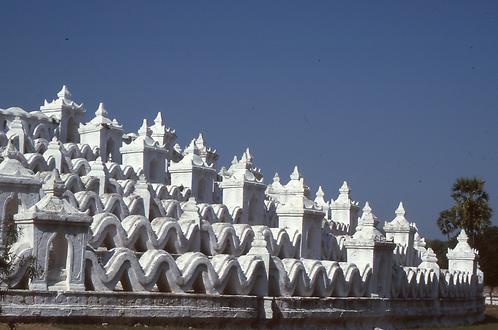Pagoda and the largest Bell in the world in Mingun on Burmas/Myanmars river Irrawaddy#
by Günther JontesAll photos were taken by the author in 2008. The photos are part of the author’s archive „picture-flood Jontes”

The powerful river that flows through Burma/Myanmar, is called Irrawaddy.
On its shores, there is a small village that shows several cultural and technical top achievements. On the one hand, it is the attempt to construct a pagoda, a Buddhist cult building which would have dwarfed everything in the world. On the other hand, it would have been ademonstation of knowelwedge by presenting the biggest bell of the world.
The Mingun Pagoda, in Burmese „Mingun- budodawkyi“ or Mantara Gyi-Pagode, should have been the biggest Buddhist building in the world with a height of 152 meters.
To honor the historical Buddha Shakyamuni, the tradition of hemispherical mounds of the Hindu funeral culture continued after his death. It developed the type of a walk around sanctuary which is called stupa. In its inner core, there is an urn which contains, at best, the relics of the religion’s founder.
Such a building has no temple room. Rather, praying people are going around the building clockwise. This is how it happens until today from Tibet to Sri Lanka and from India to East Asia.
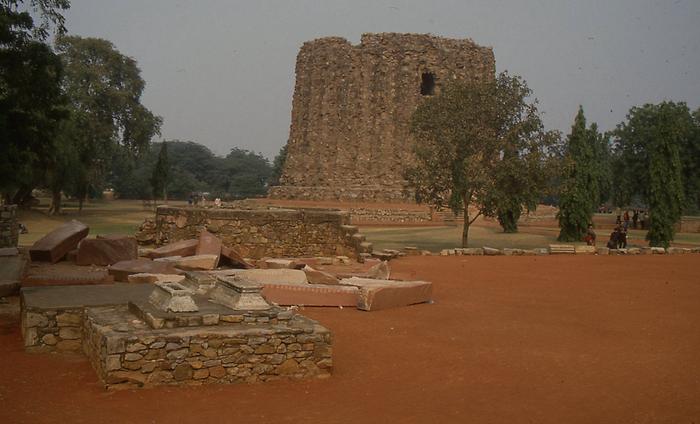
The construction was started in 1790, but never completed. The construction was stopped after the death of the king. At the basis the remains have a length of 72 meters and a heigth of 50 meters. The rest was damaged considerably during an earthquake, not rate in Burma.
The construction does not consist of cut stone as is the case in other prominent pagodas, but of bricks in order to reach the planned height of 152 meters. But one wonders where they have taken the timber in such quantities in order to burn the bricks from the abundant clay of the river sediments. it is possible that this was also a reason for stopping the construction.
In South Asia, there is another example of a never finished building construction. It is a minaret in India’s capital Dehli. In the 14th century next to the mosque Qutb ul-Islam, a trulxy monstrous building was planned, called Ala-i-Minar. It would have been built in the honor of Islam and was the result of a despotic building passion. A 150 meters high minaret was planned, but never completed.
The body of the Mingun mosque rests in itself with the whole weight so that a collapse cannot be expected at the level teh building has reached. However, after the earthquake there are wide cracks and crevices in the architecture in which partly vegetation has taken root. So far, the gigantic brick building has not collapsed.
The base of the building, where the pagoda begins to taper, is very solidly constructed and very well preserved.The base is one of the most vulnerable areas of the building. Water has to be kept away from it, that could reach the foundation. In a considerable part of architectural history of the world, there is the principle of water spoutes that remove water from the dangerous area. This is also evident in many Gothic cathedrals.
In the four directions, the edge of the pagoda is interrupted by niches that are designed like doors. The niches give the pagoda an element of an elegant decoration. Today, the niches are partly filled wiht falling masonry. One of the most admirable craft activities is the casting of bells. In the Middle Ages, West and East have brought this art to full bloom, although the intention of the use partly differs. Two elements are inseparable. On the one hand, a mold has to be made in order to create another sounding mold with a thin wall compared to the total size. There is one casting core that has to be made from special sand. A special metal alloy has to be used, the composition of which influences the sound a lot. It has to be an exactly calculated quantitythat fills totally the mold. Then, there is the casting, that is risky till the end. If it fails, a work for weeks will come to nothing.
The Mingun bell is the largest working bell in the world. In fact, there is a larger one on the grounds of the Moscow Kremlin. It is called “Emperor of all bells” (in Russian: Tsar Kolokol), but it was broken after the casting and never rang. The Mingun bell was designed to be put into the large pagoda, but remained without pagoda to house it and it just stood there for a long time without use. At the beginning of the 20th century it was hung in a belfry which was constructed for this purpose on the ground.
The bell weighs 90 tons, has a height of 6 meters and a diameter of 3 meters. In contrast to European bells it is without decoration. Its dimensions are felt as gigantic, when you see next to the bell the two young monks passing by, when fetching food.
When visiting Mingun you should also see the nearby situated beautiful Hsinbyume-Pagoda, in Burmese Sinbyume sedi. It bears the name of the favorite wife of King Bagyidaw, who built the pagoda after her death in reverence and sorrow. In its construction, it corresponds to the Buddhist conception of the world which derives from Hinduism. The mountain Meru, on which the gods rest (whoes existence was never denied by Buddha) is the center of the world. The King of the Gods and the Lord of Thunderstorms Indra is reigning on Meru.The actual pagoda as a central building represents the Meru. It can be reached through seven gates, leading over marine terraces. The peak of the Meru is gold plated and decorated with precious stones. The Meru calls the pilgrims already from far away.
It is situated in mid of the seven mythical seas which are depicted by wavelike architectures. Sitting in niches, many deities are protecting the construction from evil influences and demons.

